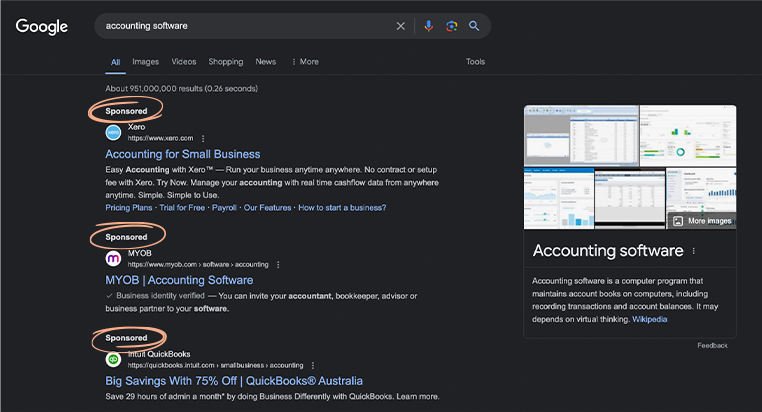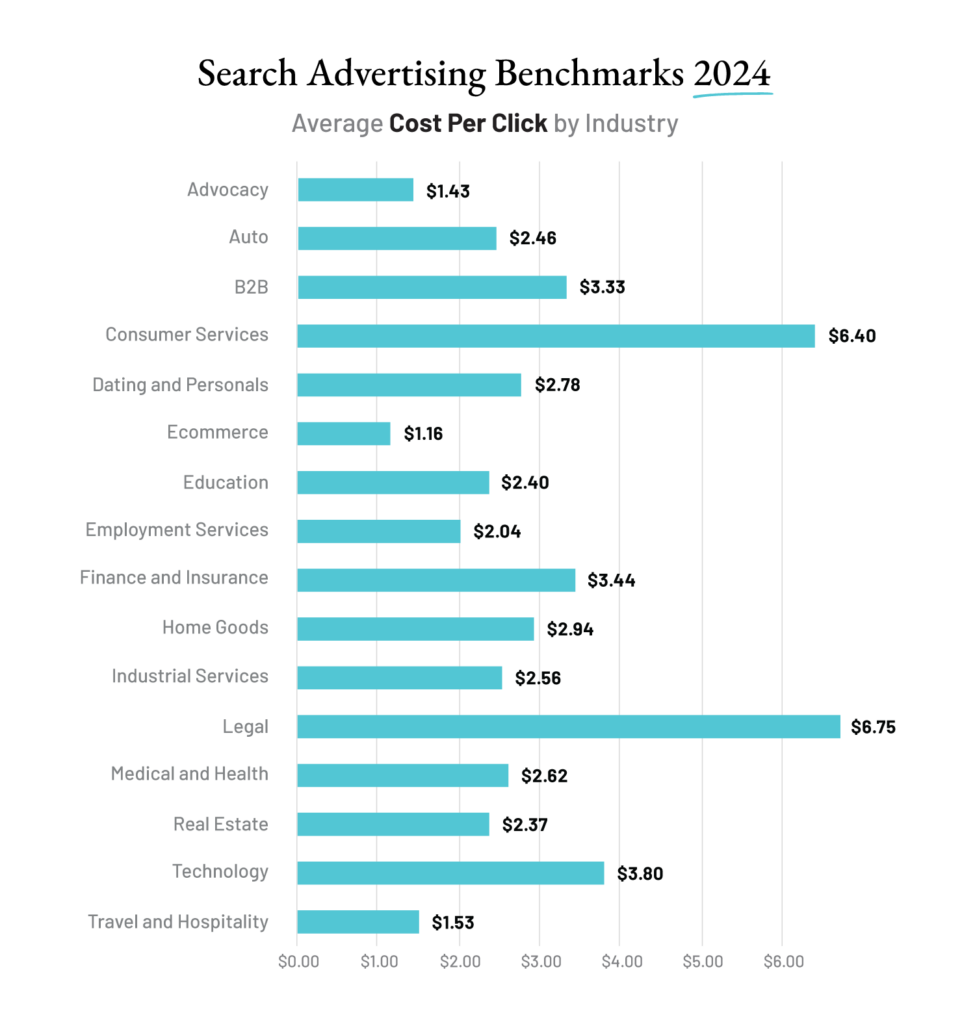Are you one of those people who avoids the first few ‘Sponsored’ results at the top of Google? Or do you click on whatever shows up first? Either way, paid search can be a cost-effective digital marketing strategy for driving traffic and reinforcing brand recognition.
Paid search refers to the practice of companies paying search engines to be placed at the top of search results. For example, a search for ‘accounting software’ returns the following top three sponsored results.

This puts your business front and centre for people who are actively searching for products like yours. But how do you secure these sponsored slots? What ballpark costs are involved? And how do you create paid search ads that are more likely to get clicks?
Here’s how to make the most of paid search opportunities.
CONTENTS
Paid search advertising works on a ‘pay per click’ basis. In other words, your ad can be shown to a lot of people and gain impressions, but you only pay each time someone clicks on it. This makes it extremely cost-effective and results-oriented. In order to secure your spot at the top of search results, a bidding process takes place.
A bidding process determines the hierarchy of sponsored ads and cost-per-click (CPC):
Paid search is distinct from SEO. While both these practices impact search ranking, SEO refers to ‘search engine optimisation’, which only has a bearing on organic search results. In other words, SEO influences the priority of results listed below the sponsored slots – the ones you can’t pay for. Whereas paid search focuses specifically on the first few results. While not all searches will return sponsored results, the majority with commercial intent generally will.
Paid search is like being placed on the shelf at eye-level in a supermarket. Customers can still find other products, but they’ll see yours first – and it’s easier to reach.
While there are key differences between B2B and B2C marketing, paid search strategy remains largely similar for both markets. Business decision-makers are still people, after all. B2B purchases tend to involve more stakeholders, so they'll take longer through the consideration phase. Purchases and budgets may need sign-off from high up, so B2B marketing will often emphasise things like ‘cost-effectiveness’, ‘easy implementation’ and ‘ROI’.
STEP #1
Firstly, you’ll need a Google Ads account.
STEP #2
Then, you need to choose the keywords that you want your ad to appear for. In other words, what search terms will someone be typing into Google in order for your product or services to be relevant to them?
Long-tail keywords are often more effective because they’re more specific. For example, results under ‘gym near me that has yoga’ will deliver more qualified clicks than ‘gym’.
STEP #3
Time to bid (as outlined above).
STEP #4
Create your ads and landing pages that the users will arrive at when they click.
STEP #5
Specify the user demographics that you’re targeting.
STEP #6
Monitor and optimise!
Not sure where to start with paid search? No worries!
Our team of digital specialists can help. We keep you in the loop every step of the way, with regular reporting and ongoing optimisation to make the most of your marketing spend. Get in touch with our B2B marketing agency.
On average, cost per click (CPC) tends to be between $2-4, although certain industries can be far more expensive. Dentistry has been known to get up into the hundreds.
The price will vary depending on the competitiveness of your particular industry and the specific search terms you want to appear for. Just like you’d have to pay more for billboard space on a busy street. For example, XX ads tend to cost more than YY.

How long does paid search take to actually start ‘working’?
Generally, you can expect to start seeing results after 2-3 months of running ads. This should at least give you an idea of how you might be able to tweak and optimise your ads. But typically, paid ad campaigns will run for longer, up to 12 months.
Businesses can test, optimise, and start to see an increasing flow of traffic over a long period. The low cost and minimal creative investment required means it becomes a very useful part of any broader multi-channel marketing campaign.
TMP continually monitors and optimises B2B search campaigns to get the most ROI for your ad spend, beyond just boilerplate best practice.
The steps involved for leveraging 1st party data is to integrate as many platforms possible. By integrating Google Analytics and Google Ads, for example, we can evaluate users’ on-site behaviour to influence ad strategy. This enables us to optimise things like keywords, ad copy, landing pages and bidding strategies.
If we can further integrate CRM or offline platforms, we can 'close the loop' to evaluate what data is an indicator that someone will actually become a paying customer. For instance, keywords A and B both generate the same amount of clicks, but keyword A might be generating twice as many paying customers.
Finally, by understanding existing data of a business and their existing customers, we can leverage this to inform bidding strategies. Namely, getting in front of people that are similar to existing customers with the objective of a lower cost per acquisition.
For B2B marketing, 7am - 7pm makes sense as your optimal window to reach people during business hours in the regions that you’re targeting.
In contrast, B2C brands pretty much have a 24/7 window as they’re making purchase decisions at all hours of the day. However, certain sectors may look to be more time-sensitive – for example, food outlets targeting late afternoon and early evening when people are starting to think about dinner.
We tailor our approach depending on the nature of your company and the objective of the campaign. We’ll typically use smart bidding and focus on conversion-based search intent when volume allows. If volume is low, our aim is to maximise clicks and we’ll tend to use manual bids.
This is where optimisation comes in. We’ll have several headline and copy variants lined up, using dynamic responsive ad formats to mix and match. This enables us to quickly find out which combination is most effective, so we can push that option or continue to refine the copy accordingly.
We look at search behaviour across different industries. For example, how Bing usage compares to Google across industries and job types. For example, the prevalence of Microsoft Edge installations depending on someone’s workplace.
Every ad needs to be backed up by a coherent path from engagement through to conversion. It’s one thing to catch a user’s attention. But if they click through to a page that doesn’t make sense to them, or doesn’t match their search intent, it’s a waste of everyone’s time. When search terms, ad copy, and landing page UX are aligned, it ensures an intuitive journey that results in more qualified leads and keeps search costs down.
While it’s a relatively simple and cost-effective marketing tactic, there’s still a lot of moving parts in successful paid search campaigns. Ask TMP for help on how to implement paid search for your business.